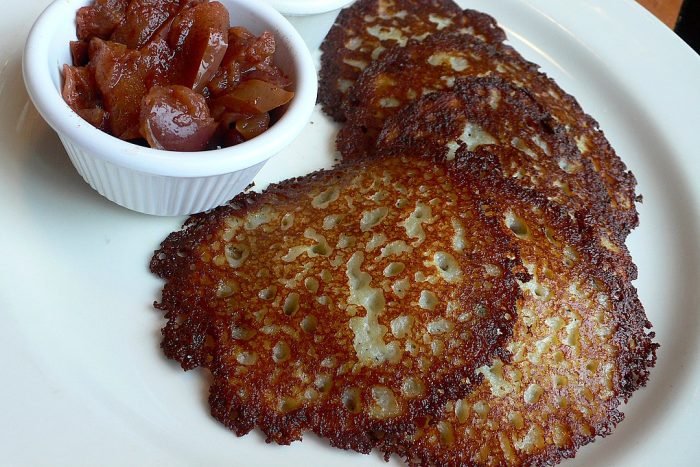Potatoes, onion, egg, bread crumbs, and oil—lots of oil.
The inner voice in my head says carbs and fats—lots of fats.
While that was many years ago, the inner debate is as clear to me as if it was yesterday.
One voice would say, “It’s fine. It’s a holiday. Be there with your family. Enjoy.” While the other provided an endless litany of why the latkes, a traditional Hanukkah meal, were not allowed.
The depriving voice would win at first, and I’d try to find loopholes. I’d use Pam instead of oil (Pam just does not fry, leaving the latkes limp and tasteless).
I’d cut back on the oil (significantly less caloric when half stuck to the pan), adding veggies to make up for the carb ratio (the zucchini latke wasn’t all bad, but it wasn’t a latke).
Exercise and more exercise to allow myself to eat.
Is that your experience?
Maybe not with latkes, but with other holiday traditions, like cookies, eggnog, or your grandma’s stuffing.
Are you trying the keto versions (I promise they are not good) or making them for your family and not yourself?
Stop. Rewind.
Holidays are about tradition and connection. This year, in particular, many of our traditions have been disrupted for the safe of safety. This is an area that you actually can control when it comes to your impulses to diet.
When you stop and think about how many of our traditions are connected to food (and I encourage you to do just that), the why of changing these patterns is clear. Families connect around food and the sharing of a meal.
It doesn’t necessarily even need to be good to make a memory. My husband and I still joke about how my mom routinely undercooked the turkey, and we would all surreptitiously “warm it up” in the microwave to escape food poisoning.
I suspect we all will be talking about that and celebrating this long after mom is no longer with us. I make desserts that have been in my husband’s family for many years and enjoy receiving friends’ heirloom food gifts.
Food obsession takes us out of these moments, robbing us of the mindful experience of being together. Our inner critic can then take over, filling our mind with rules, what-ifs, and criticism.
When the inner critic gains a voice, we rarely win because even a bite of a “forbidden” food becomes proof of our inadequacy.
When we restrict food choices, we also send powerful messages to our children and ourselves. As a therapist myself, I talk with adults who have memories of a mom who never came to the table and ate with the family or a mom who prepared a whole different meal for herself.
Especially for the daughters, the message becomes one of self-denial. It’s easy to infer the reason mom is chowing down on a Weight Watchers turkey dinner rather than the family’s favorite lasagna.
Children learn that controlling weight and the body is the most important thing, even more so than being a part of the celebration. The message to the inner self can be equally upsetting; it proves our own gluttony should deviate from rigid patterns.
What can we teach our children and tell ourselves instead?
We can teach that food is not bad. It provides a loving connection that we can enjoy fully, with a sense of appreciation.
We can also teach that they can have foods that satisfy them physically and emotionally.
The message to ourselves: we are worthy of feeding and treating ourselves well.







Read 12 comments and reply